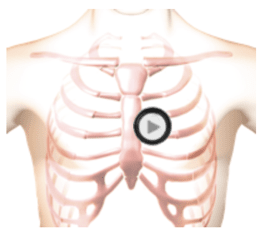Mild Aortic Regurgitation Lesson
Where to Auscultate


The patient was sitting leaning forward during auscultation.
Description
In mild aortic regurgitation murmurs, the first heart sound is diminished due to premature closure of the mitral valve leaflets. An aortic ejection click follows the first heart sound by 75 milliseconds and the second heart sound is normal. Systole is silent. A high-pitched decrescendo murmur occupying the first half of diastole can be heard beginning immediately after the second heart sound.
This murmur should be auscultated at Erb's Point, and can be accentuated by having the patient sitting up and leaning forward holding his breath after expiration.
The murmur can be caused by a bicuspid (thickened) aortic valve. In the cardiac animation, observe turbulent blood flow from the aorta into the left ventricle in early diastole. Also observe the minimally thickened aortic valve leaflets.
Phonocardiogram
Anatomy
Mild Aortic Regurgitation
Authors and Sources
Authors and Reviewers
-
Heart sounds by Dr. Jonathan Keroes, MD and David Lieberman, Developer, Virtual Cardiac Patient.
- Lung sounds by Diane Wrigley, PA
- Respiratory cases: William French
-
David Lieberman, Audio Engineering
-
Heart sounds mentorship by >W. Proctor Harvey, MD
- Special thanks for the medical mentorship of Dr. Raymond Murphy
- Reviewed by Dr. Barbara Erickson, PhD, RN, CCRN.
-
Last Update: 11/10/2021
Sources
-
Heart and Lung Sounds Reference Library
Diane S. Wrigley
Publisher: PESI -
Impact Patient Care: Key Physical Assessment Strategies and the Underlying Pathophysiology
Diane S Wrigley & Rosale Lobo - Practical Clinical Skills: Lung Sounds
- PESI Faculty - Diane S Wrigley
-
Case Profiles in Respiratory Care 3rd Ed, 2019
William A.French
Published by Delmar Cengage -
Essential Lung Sounds
by William A. French
Published by Cengage Learning, 2011 -
Understanding Lung Sounds
Steven Lehrer, MD
-
Clinical Heart Disease
W Proctor Harvey, MD
Clinical Heart Disease
Laennec Publishing; 1st edition (January 1, 2009) -
Heart and Lung Sounds Reference Guide
PracticalClinicalSkills.com